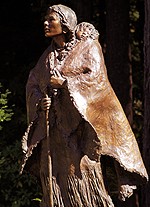Sacagawea and Jean Baptiste Sculpture

Art critics and scholars refer to Glenna Goodacre, whose career spans more than five decades, as America’s sculptor. Her works as both painter and sculptor touch on themes from the nation’s history. Goodacre’s public art includes the Vietnam Women’s Memorial in Washington, D.C.; Philadelphia’s Irish Memorial to commemorate the 150th anniversary of the Irish potato famine; and Sacagawea on the obverse side of the millennium golden dollar coin.
This bronze was selected by Richard Bertea and donated to Lewis & Clark in honor of his wife, trustee Hyla Holmes Bertea, and their daughter, Beth Bay Bertea BA ’94. It is permanently installed southeast of Frank Manor House.
Sacagawea joined the Corps of Discovery in 1804, when her husband, Toussaint Charbonneau, was hired as an interpreter. She eventually became a translator herself. A Lemhi Shoshone Indian, Sacagawea spoke not only Shoshoni but also Hidatsa, which she used to communicate with her husband, who spoke Hidatsa and French. Charbonneau’s words were then translated from French to English by other members of the Corps.
Sacagawea’s importance to the Corps became evident as she remembered the lay of the land and key passages that cut days off travel time. Her knowledge of local plants was useful when food was scarce, and, when the group’s canoes capsized, Sacagawea saved many valuable documents and notes from the river. Not only did her presence allow the Corps safe passage across many native lands—a woman and child were signals that the expedition was of a peaceful nature—but her standing as a Shoshone allowed them to barter for horses to cross the Rocky Mountains.
Sacagawea’s significance was acknowledged by Lewis and Clark on November 24, 1805, when she was asked to vote with the rest of the expedition to determine the location of their winter camp. Despite this recognition, she received nothing when the expedition concluded.
Main
503-768-7000
Visiting Us
Lewis & Clark
615 S. Palatine Hill Road
Portland OR 97219